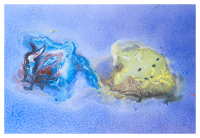Speaker
Dr
Grigory Feofilov
(Saint-Petersburg State University)
Description
Some sudden change in two-dimensional two-particle angular correlations (i.e. the onset of a so-called near-side «ridge» structure, localized in azimuth and extended in pseudorapidity) was observed by STAR collaboration at RHIC in AuAu collisions at 62 and 200 GeV [1]. It was shown for the first time that this change occurs at a specific Au-Au centrality, common to both energies. These results motivated the study [2] where the hypothesis of string percolation phase transition was used as a natural explanation of the conditions of the given onset. More
detailed experimental data analysis appeared recently and the obtained centrality trends of Au-Au angular correlations were compared in [3] to generic models of nucleus-nucleus collisions including Glauber linear superposition of N-N collisions, parton/hadron rescattering in a dissipative medium and a locally thermalized “opaque» medium.
In the present work we continue studies started in [2] focusing at the onset and the more accurate determination of the string percolation model parameters by using the data [3]. String percolation model was successfully used recently in [4] to qualitatively explain the dependence of the pseudorapidty and azimuthal widths of ridge structure on multiplicity and energy.
Our approach developed previously in [2] is briefly described. Modified Bjorken formula calculations are performed for the local energy densities in AA collisions at different impact-parameters (centralities) and with account of the latest data available on the charged particles densities at midrapidity. Finally we compare variations of mean local energy and of string densities and match the occurrence of the critical percolation phenomenon with the critical energy density value, considering them at the same values of centrality. The condition of the onset of the near-side ridge in AA collisions, that happens at some definite ("critical") number of participating nucleons, is found to be consistent with the hypothesis of the string percolation phase transition. Extrapolations of model results to the other colliding systems and energies are discussed.
The authors G.F. and I.A. acknowledge Saint-Petersburg State University
for a research grant 11.38.66.2012
References:
[1] M.Daugherity (STAR
Collaboration), J. Phys. G35 (2008) 104090, arXiv:0806.2121v2
[nucl-ex] 2008; M. Daugherity// Report on QM2008.;
[2] O.Kochebina, G.Feofilov , Onset of "ridge phenomenon" in AA and pp
collisions and percolation string model, arXiv.org ( hep-ph
)arXiv:1012.0173, 1 Dec 2010.
[3] G.Agakishev et al., Anomalous centrality evolution of two-particle
angular correlations from Au-Au collisions at.sNN = 62 and 200 GeV,
Phys.Rev. C86, 064902(2012).
[4] C. Andres, A. Moscoso, and C. Pajares, On the onset of the ridge
structure in AA, pA and pp collisions, arXiv: 1405.3632v2[hep-ph]17 May 2012.
- List item
Summary
The condition of the onset of the near-side ridge in AA collisions, that happens at some definite ("critical") number of participating nucleons, is found to be consistent with the hypothesis of the string percolation phase transition. Extrapolations of model results to the other colliding systems and energies are discussed.
Author
Dr
Grigory Feofilov
(Saint-Petersburg State University)
Co-authors
Dr
Igor Altsybeev
(Saint Petersburg State University)
Ms
Olga Kochebina
(Laboratoire de l'Accélérateur Linéaire (LAL), CNRS : UMR8607 – IN2P3 – Université Paris XI - Paris Sud)
